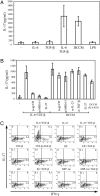IL-6-dependent and -independent pathways in the development of interleukin 17-producing T helper cells
- PMID: 17623780
- PMCID: PMC1924582
- DOI: 10.1073/pnas.0705268104
IL-6-dependent and -independent pathways in the development of interleukin 17-producing T helper cells
Abstract
CD4(+) T cells producing IL-17 [T helper (Th)17], as distinct from Th1 or Th2 cells, have recently been shown to be associated with autoimmunity, but it is not entirely clear how Th17 cells are generated from naïve T cells. We demonstrate here that IL-6, but not TNF-alpha or IL-1beta, can, in combination with TGF-beta, induce Th17 cell generation from naïve T cells and inhibit TGF-beta-induced Foxp3 expression. Moreover, conditioned medium from lipopolysaccharide-stimulated bone marrow-derived dendritic cells (DCCM) can induce IL-17 production in naïve T cells. Interestingly, IL-17 was produced by DCCM even with the addition of anti-gp130 antibody or DCCM from IL-6 KO mice. The combination of IL-6 and TGF-beta could maintain activation of signal transducer and activator of transcription (Stat)3, but not of Stat1. IL-27 or IFN-gamma suppressed the induction of Th17 cells by TGF-beta plus IL-6 and maintained Stat1 activation under these conditions. In contrast, both Stat1 and Stat3 remained to be activated in naïve T cells cultured with DCCM. These findings represent a different basis for Th17 differentiation from naïve T cells.
Conflict of interest statement
The authors declare no conflict of interest.
Figures





References
-
- Fontenot JD, Rasmussen JP, Williams LM, Dooley JL, Farr AG, Rudensky AY. Immunity. 2005;22:329–341. - PubMed
-
- Szabo SJ, Kim ST, Costa GL, Zhang X, Fathman CG, Glimcher LH. Cell. 2000;100:655–669. - PubMed
-
- Zheng W, Flavell RA. Cell. 1997;89:587–596. - PubMed
-
- Hsieh CS, Macatonia SE, Tripp CS, Wolf SF, O'Garra A, Murphy KM. Science. 1993;260:547–549. - PubMed
Publication types
MeSH terms
Substances
LinkOut - more resources
Full Text Sources
Other Literature Sources
Research Materials
Miscellaneous

